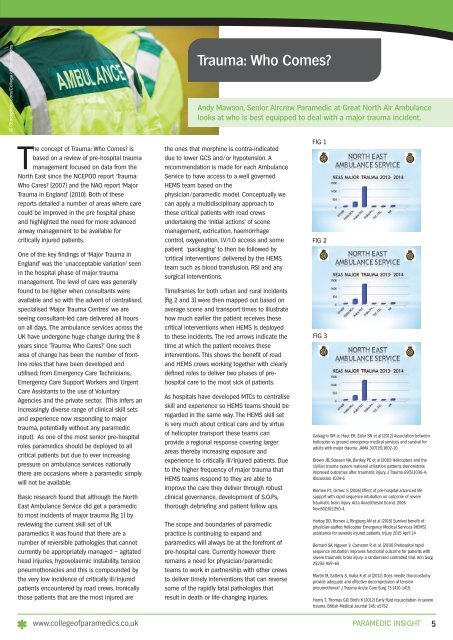paramedics
1K3uFjH
1K3uFjH
- No tags were found...
Create successful ePaper yourself
Turn your PDF publications into a flip-book with our unique Google optimized e-Paper software.
© iStockphoto.com/College of ParamedicsTrauma: Who Comes?Andy Mawson, Senior Aircrew Paramedic at Great North Air Ambulancelooks at who is best equipped to deal with a major trauma incident.The concept of Trauma: Who Comes? isbased on a review of pre-hospital traumamanagement focused on data from theNorth East since the NCEPOD report ‘Trauma:Who Cares? (2007) and the NAO report ‘MajorTrauma in England’ (2010). Both of thesereports detailed a number of areas where carecould be improved in the pre hospital phaseand highlighted the need for more advancedairway management to be available forcritically injured patients.One of the key findings of ‘Major Trauma inEngland’ was the ‘unacceptable variation’ seenin the hospital phase of major traumamanagement. The level of care was generallyfound to be higher when consultants wereavailable and so with the advent of centralised,specialised ‘Major Trauma Centres’ we areseeing consultant-led care delivered all hourson all days. The ambulance services across theUK have undergone huge change during the 8years since 'Trauma: Who Cares?' One sucharea of change has been the number of frontlineroles that have been developed andutilised; from Emergency Care Technicians,Emergency Care Support Workers and UrgentCare Assistants to the use of VoluntaryAgencies and the private sector. (This infers anincreasingly diverse range of clinical skill setsand experience now responding to majortrauma, potentially without any paramedicinput). As one of the most senior pre-hospitalroles <strong>paramedics</strong> should be deployed to allcritical patients but due to ever increasingpressure on ambulance services nationallythere are occasions where a paramedic simplywill not be available.Basic research found that although the NorthEast Ambulance Service did get a paramedicto most incidents of major trauma (fig 1) byreviewing the current skill set of UK<strong>paramedics</strong> it was found that there are anumber of reversible pathologies that cannotcurrently be appropriately managed – agitatedhead injuries, hypovolaemic instability, tensionpneumothoracies and this is compounded bythe very low incidence of critically ill/injuredpatients encountered by road crews. Ironicallythose patients that are the most injured arethe ones that morphine is contra-indicateddue to lower GCS and/or hypotension. Arecommendation is made for each AmbulanceService to have access to a well governedHEMS team based on thephysician/paramedic model. Conceptually wecan apply a multidisciplinary approach tothese critical patients with road crewsundertaking the ‘initial actions’ of scenemanagement, extrication, haemorrhagecontrol, oxygenation, I.V/I.O access and somepatient ‘packaging’ to then be followed by‘critical interventions’ delivered by the HEMSteam such as blood transfusion, RSI and anysurgical interventions.Timeframes for both urban and rural incidents(fig 2 and 3) were then mapped out based onaverage scene and transport times to illustratehow much earlier the patient receives thesecritical interventions when HEMS is deployedto these incidents. The red arrows indicate thetime at which the patient receives theseinterventions. This shows the benefit of roadand HEMS crews working together with clearlydefined roles to deliver two phases of prehospitalcare to the most sick of patients.As hospitals have developed MTCs to centraliseskill and experience so HEMS teams should beregarded in the same way. The HEMS skill setis very much about critical care and by virtueof helicopter transport these teams canprovide a regional response covering largerareas thereby increasing exposure andexperience to critically ill/injured patients. Dueto the higher frequency of major trauma thatHEMS teams respond to they are able toimprove the care they deliver through robustclinical governance, development of S.O.Ps,thorough debriefing and patient follow ups.The scope and boundaries of paramedicpractice is continuing to expand and<strong>paramedics</strong> will always be at the forefront ofpre-hospital care. Currently however thereremains a need for physician/paramedicteams to work in partnership with other crewsto deliver timely interventions that can reversesome of the rapidly fatal pathologies thatresult in death or life-changing injuries.FIG 1FIG 2FIG 3Galvagno SM Jr, Haut ER, Zafar SN et al (2012) Association betweenhelicopter vs ground emergency medical services and survival foradults with major trauma. JAMA 307(15):1602-10Brown JB, Stassen NA, Bankey PE et al (2010) Helicopters and thecivilian trauma system: national utilization patterns demonstrateimproved outcomes after traumatic injury. J Trauma 69(5):1030-4;discussion 1034-6Klemen P1, Grmec S (2006) Effect of pre-hospital advanced lifesupport with rapid sequence intubation on outcome of severetraumatic brain injury. Acta Anaesthesiol Scand. 2006Nov;50(10):1250-4.Hartog DD, Romeo J, Ringburg AN et al (2015) Survival benefit ofphysician-staffed Helicopter Emergency Medical Services (HEMS)assistance for severely injured patients. Injury 2015 April 14Bernard SA, Nguyen V, Cameron P, et al. (2010) Prehospital rapidsequence intubation improves functional outcome for patients withsevere traumatic brain injury: a randomized controlled trial. Ann Surg252(6): 959–65Martin M, Satterly S, Inaba K et al (2012) Does needle thoracostomyprovide adequate and effective decompression of tensionpneumothorax? J Trauma Acute Care Surg 73:1410-1415.Harris T, Thomas GO, Brohi K (2012) Early fluid resuscitation in severetrauma. British Medical Journal 345: e5752www.collegeof<strong>paramedics</strong>.co.ukPARAMEDIC INSIGHT5


